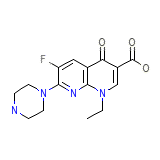Enoxacin




Enoxacin Brand names, Enoxacin Analogs
Enoxacin Brand Names Mixture
- No information avaliable
Enoxacin Chemical_Formula
C15H17FN4O3
Enoxacin RX_link
http://www.rxlist.com/cgi/generic2/enoxacin.htm
Enoxacin fda sheet
Enoxacin msds (material safety sheet)
Enoxacin Synthesis Reference
No information avaliable
Enoxacin Molecular Weight
320.319 g/mol
Enoxacin Melting Point
220-224 oC
Enoxacin H2O Solubility
3.43 g/L
Enoxacin State
Solid
Enoxacin LogP
0.387
Enoxacin Dosage Forms
200 mg and 400 mg film-coated tablets
Enoxacin Indication
For the treatment of adults (≥18 years of age) with the following infections caused by susceptible strains of the designated microorganisms: (1) uncomplicated urethral or cervical gonorrhea due to Neisseria gonorrhoeae, (2) uncomplicated urinary tract infections (cystitis) due to Escherichia coli, Staphylococcus epidermidis, or Staphylococcus saprophyticus, and (3) complicated urinary tract infections due to Escherichia coli, Klebsiella pneumoniae, Proteus mirabilis, Pseudomonas aeruginosa, Staphylococcus epidermidis, or Enterobacter cloacae.
Enoxacin Pharmacology
Enoxacin is a quinolone/fluoroquinolone antibiotic. Enoxacin is bactericidal and its mode of action depends on blocking of bacterial DNA replication by binding itself to an enzyme called DNA gyrase, which allows the untwisting required to replicate one DNA double helix into two. Enoxacin is a broad-spectrum antibiotic that is active against both Gram-positive and Gram-negative bacteria. Enoxacin may be active against pathogens resistant to drugs that act by different mechanisms.
Enoxacin Absorption
Rapidly absorbed following oral administration, with an absolute oral bioavailability of approximately 90%.
Enoxacin side effects and Toxicity
No information avaliable
Enoxacin Patient Information
Enoxacin Organisms Affected
Enteric bacteria and other eubacteria














